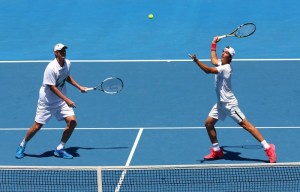by Marty Smith
@MartySmithAT
Marty Smith is the director of tennis at the New York Athletic Club and the author of the book “The Absolute Tennis: The Best And Next Way To Play The Game” for sale here https://www.amazon.com/dp/1937559742/ref=cm_sw_r_tw_dp_U_x_HLsoAbDGYAW4F
Choosing the right doubles partner
Finding the right doubles partner isn’t always easy, but when you do, the victories and extra fun on the court will usual follow closely behind. To pick the right doubles partner, first you must understand your own strengths and weaknesses and then look for a partner who complements your playing style and thus creates a synergy. For example, if you have a strong serve, try to find a partner who is skilled at the net and can take advantage of the opportunities that stem from your powerful serve. Or, if movement isn’t your strong suit, look for a partner who moves well to cover the lobs and drop shots. Combining contrasting types of hitters can be effective too. For example, if you are a player who uses a lot of spin on groundstrokes, teaming up with a flat baseline power hitter will force your opponents to continually defend against shots coming at them at different speeds and trajectories. In general, a power player should team up with a consistent player and vice versa. A team of two power players may be susceptible to racking up unforced errors on a bad day, while two steady players together may lack the explosiveness to hit winners or force enough errors.
In picking a partner, a major consideration is your partner’s preferred side of the court to receive serve and whether that choice complements your favored side. Which side should you favor? It partly depends on what direction you prefer to hit your strongest groundstroke, and since most players favor their forehand over their backhand, the direction you prefer to hit the forehand is an important factor. If you like to “pull” the forehand cross-court, then you may feel most comfortable playing the deuce side. Or, if you enjoy hitting the inside-out forehand, then play the ad side. If your backhand is the stronger groundstroke, then the direction you favor hitting that shot should be highlighted. Keep in mind, unlike in singles, because you only have half of a doubles court to cover, you can position yourself on the baseline to use your strongest groundstroke the majority of the time.
If there is a skill level difference between you and your partner, the stronger partner usually plays the ad side. That’s because the ad side has most of the “big” points and the right-handed ad side player can hit most of the overheads. Furthermore, the poaching forehand volley is done from the ad side; and because the forehand volley permits more time and reach than the backhand volley, more opportunities will arise to intercept balls for the ad side player.
Personality is also a consideration in selecting a teammate. Remember that there is a lot of down time between points; it is important that you spend that time with a partner with whom you produce a good match tempo. As former #1 world ranked doubles player Todd Woodbridge said of his partner Mark Woodforde in www.intheblack.com, “With Mark, I was youthful and exuberant and full of fire. Mark was more “even” and so could pull the team down and maintain it, while I could get the team fired up and motivated when when it needed to be.” If you tend to rush through matches, choose someone whose internal clock runs a little more slowly than yours. A doubles team of two “fast-forward” players often play well when leading, but after three or four consecutive games, they are unlikely to slow down to stop the momentum. Conversely, if your mind works in a more deliberate fashion, pick someone who can turn up the emotional tempo during a flat spot of a match.
Also remember that it is helpful to get along well with your partner. This makes it more likely that you will practice together more often and understand each other’s game better. Spending a lot of time practicing together will help you determine who should defend the lob and balls hit towards the middle of the court. It will also help you to get to know your teammate’s strengths and weaknesses as well as their cross-court and down-the-line tendencies. This knowledge will help you get a jump start moving forward, back, right, or left to best cover the court. Also, if you enjoy each other’s company you will communicate well — a key component of any successful doubles team. By having open lines of communication, your strategy is more likely to be complete, as you might notice something in the opposing team’s game that your partner didn’t see or vice versa. Good communication also ensures you stay positive as a team. Positive talk helps keep morale high and makes the game fun. And if you are having fun, you will compete with greater energy, stay relaxed, and win more too!

